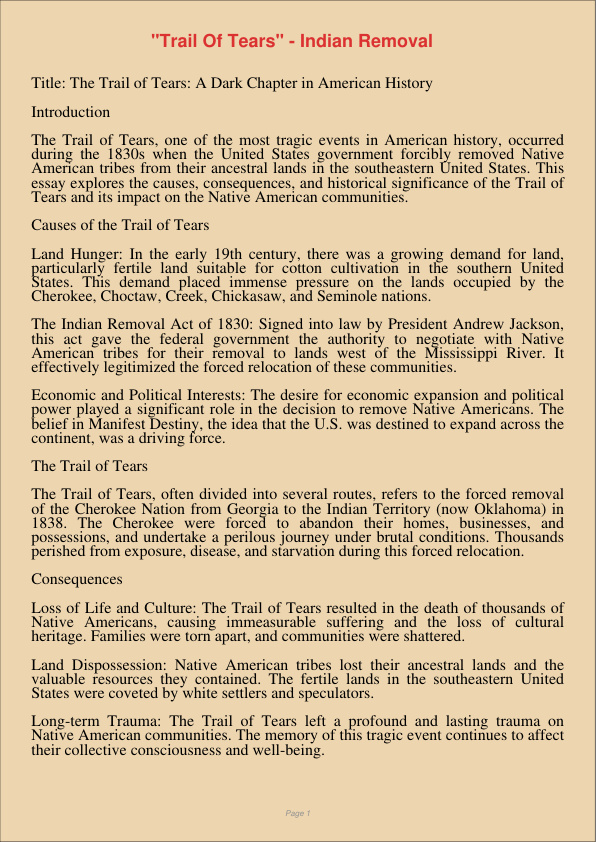Trail Of Tears Indian Removal
Dec 31, 2023
indian removal
trail
Family & Consumer Science
English
Title: The Trail of Tears: A Dark Chapter in American History
Introduction
The Trail of Tears, one of the most tragic events in American history, occurred during the 1830s when the United States government forcibly removed Native American tribes from their ancestral lands in the southeastern United States. This essay explores the causes, consequences, and historical significance of the Trail of Tears and its impact on the Native American communities.
Causes of the Trail of Tears
Land Hunger: In the early 19th century, there was a growing demand for land, particularly fertile land suitable for cotton cultivation in the southern United States. This demand placed immense pressure on the lands occupied by the Cherokee, Choctaw, Creek, Chickasaw, and Seminole nations.
The Indian Removal Act of 1830: Signed into law by President Andrew Jackson, this act gave the federal government the authority to negotiate with Native American tribes for their removal to lands west of the Mississippi River. It effectively legitimized the forced relocation of these communities.
Economic and Political Interests: The desire for economic expansion and political power played a significant role in the decision to remove Native Americans. The belief in Manifest Destiny, the idea that the U.S. was destined to expand across the continent, was a driving force.
The Trail of Tears
The Trail of Tears, often divided into several routes, refers to the forced removal of the Cherokee Nation from Georgia to the Indian Territory (now Oklahoma) in 1838. The Cherokee were forced to abandon their homes, businesses, and possessions, and undertake a perilous journey under brutal conditions. Thousands perished from exposure, disease, and starvation during this forced relocation.
Consequences
Loss of Life and Culture: The Trail of Tears resulted in the death of thousands of Native Americans, causing immeasurable suffering and the loss of cultural heritage. Families were torn apart, and communities were shattered.
Land Dispossession: Native American tribes lost their ancestral lands and the valuable resources they contained. The fertile lands in the southeastern United States were coveted by white settlers and speculators.
Long-term Trauma: The Trail of Tears left a profound and lasting trauma on Native American communities. The memory of this tragic event continues to affect their collective consciousness and well-being.
Legal Precedent: The event set a dangerous legal precedent for the federal government’s authority to forcibly remove indigenous people from their homelands.
Historical Significance
The Trail of Tears remains a symbol of the deep injustices faced by Native American communities in their interactions with European settlers and the U.S. government. It also highlights the larger issues of land dispossession, forced assimilation, and cultural destruction faced by indigenous populations throughout American history.
Conclusion
The Trail of Tears is a somber reminder of the painful history of Native American communities and the legacy of colonialism in the United States. Recognizing and understanding this dark chapter in American history is essential for acknowledging past injustices and working towards reconciliation and justice for Native American communities today. It serves as a reminder that the story of the United States is one of complex interactions between diverse cultures and the consequences of such interactions on marginalized communities.
